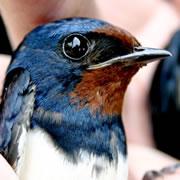 Migratory birds such as swallows seem more vulnerable to radiation.Tim Mousseau
Migratory birds such as swallows seem more vulnerable to radiation.Tim MousseauBirds with bright plumage have suffered most from radiation around the Chernobyl nuclear plant, scientists have discovered. Species that lay large eggs or travel long distances are also more susceptible to radiation.
All of these traits require large quantities of the antioxidant molecules that protect cells. Investing in them leaves birds with fewer to counter the effects of radiation, say the researchers behind the discovery.
Timothy Mousseau, of the University of South Carolina in Columbia, and his colleague Anders Møller, from the University of Pierre and Marie Curie in Paris, counted more than 1,500 birds from 57 species in the woods around the reactor, comparing areas of high radioactivity with nearby uncontaminated sites.
They found that birds with colourful red, yellow or orange plumage based on organic pigments called carotenoids, such as orioles and blue tits, were much less abundant in contaminated areas than their more dowdy relatives, such as tree pipits, coal tits and chaffinches. Species laying large eggs and those that migrate over large distances were also particularly scarce.
Antioxidants mop up free radicals — reactive molecules produced as a byproduct of metabolism and in response to exposure to radiation — which can damage DNA and proteins. The study is published in the Journal of Applied Ecology1.
Dangerous radicals
Carotenoid pigments are powerful antioxidants. As well as using them in plumage, birds cram them into their eggs to protect the developing embryo from free radicals — this is what makes yolk yellow.
Migrating birds, meanwhile, burn a lot of fuel, and produce lots of free radicals in the process.
Mousseau believes his results show that conserving antioxidants is the key to surviving in an area such as Chernobyl. Animals that splurge most of their supply on, for instance, producing colourful feathers might not have enough left over to protect their DNA from radiation damage. That can result in higher mutation rates and, ultimately, population decline, says Mousseau.
"Overall we found that population size and abundance decreased," says Mousseau. "However, a few species actually increased in contaminated areas — we don't know why, but it could be due to decreased competition in these areas. The take-home message is that there is tremendous variability in the way that different species cope with radiation."
ADVERTISEMENT
But more research will be needed to determine conclusively whether the radiation levels around Chernobyl are strong enough to affect birds, says geneticist Yuri Dubrova of the University of Leicester, UK.
"This is very interesting data," he says. "If correct, it potentially indicates that low-level radiation is more harmful than previously assumed."
Visit our birdsarebetteroff.html">newsblog to read and post comments about this story.
